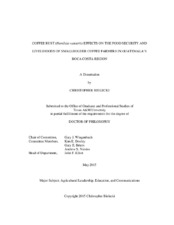| dc.description.abstract | The purpose of this study was to develop a framework to understand how coping mechanisms and livelihood diversification strategies were used to mitigate the coffee leaf rust’s (CLR) effects on the food security and livelihoods of Guatemalan smallholder coffee farmers. This research used a qualitative instrumental case study methodology to develop a grounded theory based on the rich description and analysis of how one Guatemalan smallholder coffee cooperative was affected by the 2012-2013 CLR epidemic.
The cooperative members perceived the CLR epidemic as one crisis of many they faced in their lives. The CLR epidemic brought significant changes to the members’ livelihoods strategy and increased food insecurity. Members reported production declines of 50 to 90 percent. Members chose to forgo organic production, borrow money, seek off-farm employment, diversify into food crops, and make major investments into renewing coffee fields infected with the CLR. The cooperative members reported ameliorating the effects of food insecurity by eating less food, skipping meals, eating less desirable foods, generating income from off-farm employment to purchase food, and borrowing money to purchase food.
Despite continual crises, and the threat of another CLR outbreak, the cooperative remained committed to producing high quality Arabica coffee. Members perceived using non-productive land to grow food crops as beneficial to improve food security. Diversifying coffee fields to produce other cash crops was not perceived as an advantageous strategy to strengthen food security or livelihoods. Despite a history of assistance from external organizations before, during, and after, the CLR epidemic, members’ livelihoods remained vulnerable. In light of the damaging effects that the CLR had on incomes, livelihoods, and food security, the cooperative’s main objective remained exporting high quality Arabica coffee.
The smallholder coffee producer vulnerability framework was developed during the course of the research. The framework is intended to be used to understand coping mechanisms and analyze changing livelihood strategies resulting from coffee production disruptions. It is recommended that future research further explore perceptions of crop diversification, coffee production, and the CLR. | en |


